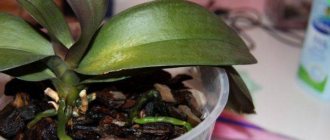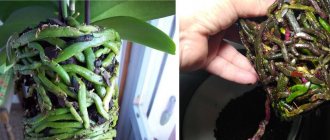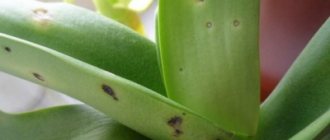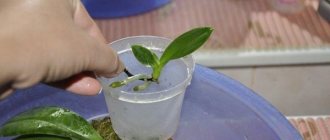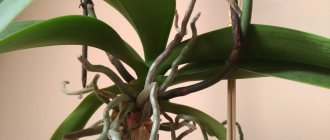Root structure
The root system of epiphytic orchid types is characterized by considerable thickness.
The top layer of roots is called rhizoderm and it is in it that active (osmotic) absorption of moisture from the environment surrounding the root occurs.
The rhizoderm of the roots of most orchid species has a slightly different structure - these cells are dead and unsuitable for osmotic absorption; moisture here moves through capillaries. In appearance, this layer resembles a porous sponge and is called velamen .
The axial cylinder is the central part of the root that conducts water. This living tissue is like a water pipe that transports water and salts dissolved in it to the stem and leaves of the orchid. The axial cylinder is covered with parenchyma .
Parenchyma is the main part of the root that provides the function of the root and absorbs water. The parenchyma is covered with a membrane, velamen.
Velamen is several layers of dead cells, empty inside, which are formed during cycles of moistening and drying, a thin layer of 0.5-1 mm.
These cells are hollow inside and provide the cellular structure of the velamen. The empty cells of dry velamen are filled with air; when water gets on the velamen, the cells are passively filled with water, the velamen gets wet like a sponge, but it is not capable of transporting water, it only lets liquid into the root.
When the orchid's roots are dry , the velamen becomes rigid and does not allow moisture to leave the plant.
Velomen not only absorbs liquid inside, but also protects the root rod from damage. Having absorbed moisture, it becomes very flexible and pliable; it can bend well without violating the integrity of the covering material.
Immediately behind the velamen there is another layer - exodermis , its cells are heterogeneous.
This structure of orchid roots allows them to survive in conditions of moisture deficiency and lack of soil. In fact, the parenchyma is the “soil” in which the orchid’s roots grow.
For successful functioning, the root must alternately be filled with moisture and completely dry, blown with air, and illuminated by the sun.
Some deviations from ideal conditions can be successfully tolerated by the plant, but systematic disturbances will ultimately lead to the death of the entire root or, as happens more often, only the parenchyma and velamen.
On the roots of orchids there are waiting buds - meristems , which begin to grow if the root system is injured. There are also buds that are located at the base of the plant and begin to grow at the moment when the flower has lost its roots due to improperly organized care.
monopodial orchids are formed along the entire shoot (phalaenopsis, vanda).
The roots of sympodial orchids have rhizomes or pseudobulbs (Cattleya, Miltonia, Oncidium, Dendrobium).
The root system of lithophytic orchids is similar to other indoor plants. The main difference is that orchids are able to not only absorb moisture with their roots, but also store nutrients.
There are a number of lithophytic orchids in which the functions of the roots are performed by some semblance of nodules. Such parts of the plant take an active part in the process of feeding the indoor orchid in winter.
In Paphiopedilum, the roots are different and have a color from yellow to light brown, covered with a skin with light hairs, through which water is absorbed into the roots.
Root diseases and flowering problems
Root diseases cause problems with flowering, but we will talk about diseases of the root system further, but weak flowering is a problem that often occurs. The main reasons for the lack of buds are as follows:
- improper watering;
- sudden changes in temperature;
- violation of rest mode;
- insufficient lighting.
Another problem is that buyers forget to check with the seller what type of plant they purchased and how exactly it blooms, as well as a general description of the plant. It is important to understand that different types of orchids produce buds and bloom at different times of the year. It often happens that the owner is looking forward to the first flowers, but only the green mass grows.
Note! Lack of light is the most common cause of plant wilting. Most varieties of orchids do not tolerate even partial shade. They need good lighting, so the plant should be placed on window sills and not in the corner of the room. The exceptions are varieties such as phalaenopsis and paphiopedilum, which can bloom in partial shade.
How to understand that an orchid does not have enough light? It is not difficult. Pay attention to the color of the leaves. The natural shade is soft green, light and even slightly muted. Bright green tones are a sign of lack of lighting. If the leaves turn yellow, then this is a signal that the plant is exposed to an excess amount of ultraviolet radiation.
What to do in such a situation? Place the plant either in a more illuminated place (in the case of bright green leaves - a clear example in the photo), or in partial shade (if you notice yellowness).
An equally common reason for the lack of flower stalks in orchids is root diseases. It is very difficult to identify this problem, especially if the plant is already flowering. The latter can be observed even in the case of rotting roots. But if a plant does not please you with either flowering or buds for a long time, it’s time to check the root system. The cause of rot (the most common) is overwatering. Remember that the plant needs to be bathed by placing it in a bowl of water for 20-40 minutes once a week. This is enough for the flower. But there is no need to fill it with water so that it stands in the pot.
What to do in such a situation? The best solution is to transplant the flower into a new pot and remove damaged areas of the roots. In principle, replanting is useful as a periodic event in plant care.
Functions of roots
A healthy orchid root performs several important functions :
- transport, absorption and storage of water and minerals;
- fixing the orchid in the substrate and on the block;
- photosynthesis;
- gas exchange.
this complex system to function normally, it must be in balance, which is provided to it by environmental factors, the main of which is light .
How does an orchid absorb water?
Under the influence of light, moisture evaporates from the entire surface of the leaves. The roots receive a “request” to transport water to the leaves.
The process of active transport begins - the cells of the axial cylinder “capture” water molecules from the velamen and further move them from cell to cell through the cell membrane. This process is called osmosis .
Velamen gradually dries out. After complete drying, the new layer of cells dies and the velamen becomes thicker.
Fixation
Orchids grow in the wild on trees, rocks and other surfaces. At the same time, plants are often exposed to heavy rains and winds; it is the roots that help the orchid to gain a good foothold on any surface.
In the natural environment, roots can reach several meters and literally stick to any surface. Surely when replanting you encountered such a problem as roots stuck to the pot?
In order not to injure should be watered before replanting ; the roots will become elastic and more pliable for manipulation.
Gas exchange
The roots of epiphytic plants exchange gases: they take in oxygen and give up carbon.
To plant orchids, you need to use only breathable mixtures or bark of different fractions to ensure a sufficient amount of air around the roots.
Photosynthesis
It is important to understand that in orchids two processes simultaneously - this is respiration , in which oxygen is consumed (the orchid breathes day and night constantly and equally) and photosynthesis , in which carbon dioxide (CO2) is absorbed: the plant takes in carbon (C), and oxygen (O2) is released into the air. The release occurs only in the light.
It is very important to provide the orchids with good lighting , but do not forget to turn off the lamps at night if the plants are developing under artificial light.
Correct and incorrect care at home
Competent care consists of the following activities:
- Avoiding excess moisture - watering is done after the nutrient substrate has dried. Under normal conditions, moderate watering is carried out once every 3-4 days.
- Controlling water hardness - salts clog capillaries. The water is first settled, and at a high concentration of calcium salts, it is boiled.
- The presence of drainage in the container with the plant is mandatory - stagnation of water leads to rotting of the roots. The bottom of the flowerpot is lined with a cushion of expanded clay or foam chips 2-3 cm thick.
- Planting phalaenopsis in a loose substrate - dense soil prevents the absorption of oxygen and the growth of the apical tip. Purchase special soil for orchids.
- The use of a translucent or transparent container for planting an orchid is required to inspect the root system and ensure the process of photosynthesis.
- Adding additional nutrients only to a moist substrate - fertilizing dry soil leads to chemical burns of the velamen and its death.
- The location of the flowerpot with a flower is away from artificial heat sources - overheating of the roots leads to their death. The optimal temperature for a butterfly orchid is 22 degrees Celsius.
- Placing phalaenopsis on window sills on the shady side of the house - exposure to direct sunlight leads to thermal burns of leaves and aerial roots.
Not allowed:
- Ultra-frequent watering with stagnant moisture.
- Moistening the soil with tap water.
- Placing a flower in a pot without a drainage pad.
- Planting a plant in garden soil.
- Planting in dishes made of ceramics or other opaque material.
- Placing mineral fertilizers on dry roots.
- Placing flowerpots near heaters and heating radiators.
- Light the plant with direct sunlight at any time of the day.
Free hanging of aerial roots is a natural phenomenon. Their growth stops with sufficient moisture and minerals. Pruning is not recommended.
What are pupated and pupated orchid roots?
During the year, orchids can either actively grow and develop, or stand still without showing signs of active growth. This often depends on the type of orchid.
You can determine which phase an orchid is in by its roots.
The actively growing tip of the root is green or light purple (depending on the pigment of the flowers), pointed, like a sharpened pencil.
Approximately 1-2 cm from the tip there is a velamen and the color of the root becomes silver. Such roots are called unpunched .
If the tip of the root is silvery and not pointed, ending in a small green dot, this means that the root is not growing at this time. This happens if the orchid is resting or has stopped growing due to unfavorable conditions. Such a root is called pupated .
Due to the tip, root growth occurs. During growth, cell division occurs, so there is no velamen at the tip of the root, there are living cells filled with juice.
How to wake up a sleeping kidney
The bud in a dormant state is located on the peduncle, at its base or in the middle. If it can be awakened artificially, then a full-fledged orchid baby can be raised.
Before starting work, you need to determine the temperature in the room. It must be at least 22°C. On the peduncle in its middle part, select about 4 nodes and cut off the scales with a knife. Lubricate the cleaned kidney with any drug that accelerates growth. After about a month, small rosettes consisting of 2-3 leaves should appear in this place. Later, roots appear on them and when they reach 2 cm, the baby needs to be cut off and transplanted into a transparent pot with substrate. Under favorable conditions and proper care, the orchid will bloom within a year.
How to distinguish dry roots from healthy ones?
A healthy root is elastic, hard, sticks out and almost does not bend, tending to break. The color of dry velamen is determined by the presence of air in the cells - silver-gray.
After getting wet , when the cells are filled with water, the green bark of the axial cylinder shines through it, the velamen looks silvery-green .
Dried velamen is gray-brown in color, which does not change with watering; the roots feel as if they are empty inside, papery; velamen is easily removed from the core, like a stocking.
What is rotting?
Rotting is the process of decay of organic substances under the action of microbial enzymes. In orchids, this problem most often occurs due to a violation of the watering regime or damage by pests and diseases. The flower loves soft diffused light and air with a humidity of 40-60%. But if any of the conditions are violated, the capricious plant immediately lets you know about it.
The main causes of rot:
- the irrigation system is broken and humidity is increased;
- reduced room temperature;
- viruses, bacterial infection or fungus;
- sunlight hits the flower less than 8-10 hours a day;
- the use of a shallow substrate led to soil compaction and delayed moisture evaporation;
- excess fertilizer;
- mechanical damage;
- pests have settled in.
Consequences
The Phalaenopsis species suffers from the same diseases as other orchids. Roots, stems, leaves, and core are susceptible to rotting:
- The stem and leaves are usually affected at the base. At first, small spots or yellowing of small areas are visible. Over time, parts of the plant become soft and brittle, and green growths of sporulation centers appear. The buds fall off and the bush staggers. In an advanced stage, the ulcers acquire a yellow or pink halo.
- The main cause of core disease is constant stagnation of water inside. This small “swamp” will serve as a breeding ground for fungal spores and their further spread.
- Rotting of the root system is clearly visible when phalaenopsis is planted in a transparent or translucent pot. If ordinary plastic or ceramic ones are used, then the problem will be revealed only after transplantation and detailed inspection. The roots change color, become darker or lighter, sometimes there is a gray coating and even algae. When pressed, moisture is released and the dead parts take on a thread-like appearance.
Rarely replanting a flower also causes rotting, because air access to the roots is difficult.
How to save a plant?
To kill the fungus that has settled on the orchid, the use of fungicidal drugs is required. Most Popular:
- Fitoverm is non-toxic and is used for home and garden flowers.
- Fitosporin-M is effective and safe, treats diseases and suppresses development.
- Myoxan - normalizes and supports immunity.
- Quadrix - has a wide spectrum of action.
In the initial stage of rot development, it is permissible to use folk remedies:
- iodine solution of 5 drops of the substance per 5 liters of water;
- infusion of garlic peel in a proportion of 10 g per 1 liter of water;
- non-concentrated soap solution;
- daily tincture of 40 g of tobacco in 1 liter of water.
How to distinguish a rotten root from a healthy one?
This can be judged by the appearance of the roots and the condition of the entire plant.
A healthy root has a smooth surface, gray-silver color before watering and green after.
The rotting root first of all changes color to brownish-brown, then shrivels and after watering nothing changes at all.
If the pot is not transparent or the roots are not visible near the walls of the pot, signs of a problem with the roots can be noticed much later, when most of the roots have already been damaged and cannot perform their functions:
- does not bring water;
- does not fix the orchid.
If, with a damp substrate, the orchid loses turgor and wrinkles the leaves , and watering does not correct the situation, and the plant wobbles in the pot or threatens to fall out, then most likely there are almost no healthy roots.
To finally make sure of this, we remove the orchid from the pot, inspect and feel the roots. A healthy root is elastic, hard, sticks out and almost does not bend, and after getting wet it becomes only slightly more elastic.
Rotten roots are dark brown; under your fingers, the velamen breaks apart and falls off, exposing an axial cylinder that looks like a wire. Sometimes there is an unpleasant odor.
What to do to prevent problems?
Prevention of healthy phalaenopsis roots consists of:
- Timely, but not excessive watering.
- Regular ventilation of the room.
- Creating a humid atmosphere by placing a container of water under the flowerpot.
- Timely monitoring of the condition of the root system and pruning of diseased roots.
- Compliance with the temperature regime for growing the plant.
- Ensuring sufficient lighting levels.
- Disinfection of the soil substrate.
Phalaenopsis orchid is a very beautiful and unpretentious plant. Its development depends on the condition of the root system. The roots of this type of epiphyte will be healthy with proper care and the creation of optimal conditions for growth. In this case, the butterfly orchid will delight you with its flowers for a long time.
Orchid processing
After trimming damaged tissue, rinse the remaining root system in a weak solution of potassium permanganate. Wipe the leaves themselves with a damp cloth soaked in the same solution. Next, sprinkle all cut areas with activated carbon. You can use regular cinnamon for these purposes.
To stimulate root formation, experienced gardeners recommend soaking the roots of the plant before planting in a solution of the drug Epin (1 drop per liter of water).
Now you need to let the orchid dry thoroughly. The drying time should be at least 3 hours, and it is even better to carry out all the preparatory work in the evening and leave the plant overnight. During this time, all moisture will evaporate, including from hard-to-reach places, such as an outlet. In addition, the cut areas will tighten a little.
The main reasons why an orchid's roots dry out
To quickly eliminate the problem, you need to find out why it happened. Most often, the roots dry out only because the owners forget about regular watering, or give the green pet less moisture than it needs.
In addition, using too hard water also has a negative effect. Unfortunately, the liquid flowing from taps only in exceptional cases meets at least the minimum quality requirements. It contains many minerals that are completely unnecessary and, moreover, harmful to flowers, but can even burn the roots.
The problem may also lie in fertilizers. If you measure the latter by eye, give them unsystematically, occasionally and in large doses, then be prepared for trouble.
Finally, the death of individual shoots is normal when your orchid is old.
Dried roots are unable to perform their basic functions. They stop supplying the plant with liquid and nutrients. As a result, excess moisture is formed, and this only aggravates the situation, because its excess threatens rotting.
Plants with dried roots retain their normal appearance for a long time. Their leaves do not lose their turgor and healthy color. Only later do they begin to turn yellow (always on top first) and wither.
Most often, root drying is observed in the cold season, when daylight hours are shortened and the air cools.






